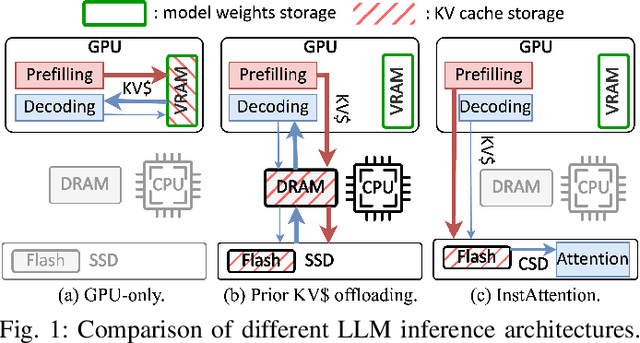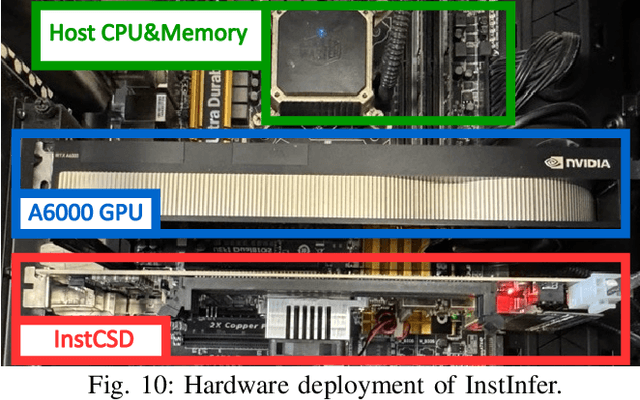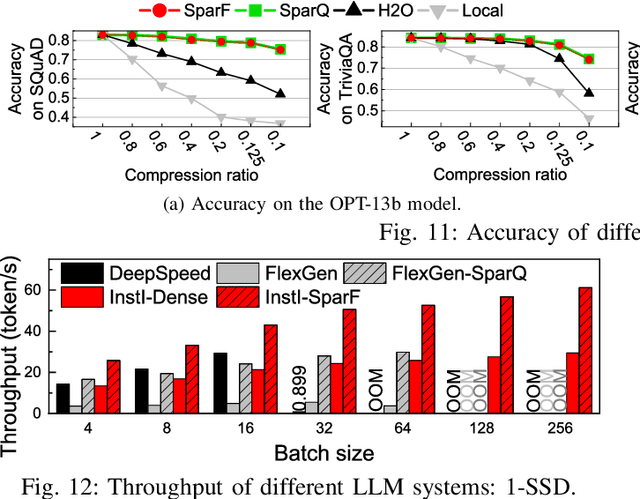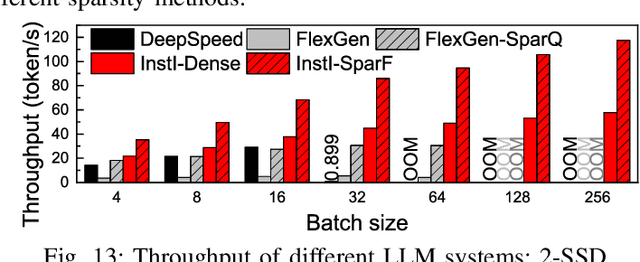Ke Zhou
SeqSAM: Autoregressive Multiple Hypothesis Prediction for Medical Image Segmentation using SAM
Mar 12, 2025Abstract:Pre-trained segmentation models are a powerful and flexible tool for segmenting images. Recently, this trend has extended to medical imaging. Yet, often these methods only produce a single prediction for a given image, neglecting inherent uncertainty in medical images, due to unclear object boundaries and errors caused by the annotation tool. Multiple Choice Learning is a technique for generating multiple masks, through multiple learned prediction heads. However, this cannot readily be extended to producing more outputs than its initial pre-training hyperparameters, as the sparse, winner-takes-all loss function makes it easy for one prediction head to become overly dominant, thus not guaranteeing the clinical relevancy of each mask produced. We introduce SeqSAM, a sequential, RNN-inspired approach to generating multiple masks, which uses a bipartite matching loss for ensuring the clinical relevancy of each mask, and can produce an arbitrary number of masks. We show notable improvements in quality of each mask produced across two publicly available datasets. Our code is available at https://github.com/BenjaminTowle/SeqSAM.
C3AI: Crafting and Evaluating Constitutions for Constitutional AI
Feb 21, 2025Abstract:Constitutional AI (CAI) guides LLM behavior using constitutions, but identifying which principles are most effective for model alignment remains an open challenge. We introduce the C3AI framework (\textit{Crafting Constitutions for CAI models}), which serves two key functions: (1) selecting and structuring principles to form effective constitutions before fine-tuning; and (2) evaluating whether fine-tuned CAI models follow these principles in practice. By analyzing principles from AI and psychology, we found that positively framed, behavior-based principles align more closely with human preferences than negatively framed or trait-based principles. In a safety alignment use case, we applied a graph-based principle selection method to refine an existing CAI constitution, improving safety measures while maintaining strong general reasoning capabilities. Interestingly, fine-tuned CAI models performed well on negatively framed principles but struggled with positively framed ones, in contrast to our human alignment results. This highlights a potential gap between principle design and model adherence. Overall, C3AI provides a structured and scalable approach to both crafting and evaluating CAI constitutions.
Learning to Learn Weight Generation via Trajectory Diffusion
Feb 03, 2025



Abstract:Diffusion-based algorithms have emerged as promising techniques for weight generation, particularly in scenarios like multi-task learning that require frequent weight updates. However, existing solutions suffer from limited cross-task transferability. In addition, they only utilize optimal weights as training samples, ignoring the value of other weights in the optimization process. To address these issues, we propose Lt-Di, which integrates the diffusion algorithm with meta-learning to generate weights for unseen tasks. Furthermore, we extend the vanilla diffusion algorithm into a trajectory diffusion algorithm to utilize other weights along the optimization trajectory. Trajectory diffusion decomposes the entire diffusion chain into multiple shorter ones, improving training and inference efficiency. We analyze the convergence properties of the weight generation paradigm and improve convergence efficiency without additional time overhead. Our experiments demonstrate Lt-Di's higher accuracy while reducing computational overhead across various tasks, including zero-shot and few-shot learning, multi-domain generalization, and large-scale language model fine-tuning.Our code is released at https://github.com/tuantuange/Lt-Di.
Enhancing AI Assisted Writing with One-Shot Implicit Negative Feedback
Oct 14, 2024



Abstract:AI-mediated communication enables users to communicate more quickly and efficiently. Various systems have been proposed such as smart reply and AI-assisted writing. Yet, the heterogeneity of the forms of inputs and architectures often renders it challenging to combine insights from user behaviour in one system to improve performance in another. In this work, we consider the case where the user does not select any of the suggested replies from a smart reply system, and how this can be used as one-shot implicit negative feedback to enhance the accuracy of an AI writing model. We introduce Nifty, an approach that uses classifier guidance to controllably integrate implicit user feedback into the text generation process. Empirically, we find up to 34% improvement in Rouge-L, 89% improvement in generating the correct intent, and an 86% win-rate according to human evaluators compared to a vanilla AI writing system on the MultiWOZ and Schema-Guided Dialog datasets.
Unsupervised Meta-Learning via Dynamic Head and Heterogeneous Task Construction for Few-Shot Classification
Oct 03, 2024



Abstract:Meta-learning has been widely used in recent years in areas such as few-shot learning and reinforcement learning. However, the questions of why and when it is better than other algorithms in few-shot classification remain to be explored. In this paper, we perform pre-experiments by adjusting the proportion of label noise and the degree of task heterogeneity in the dataset. We use the metric of Singular Vector Canonical Correlation Analysis to quantify the representation stability of the neural network and thus to compare the behavior of meta-learning and classical learning algorithms. We find that benefiting from the bi-level optimization strategy, the meta-learning algorithm has better robustness to label noise and heterogeneous tasks. Based on the above conclusion, we argue a promising future for meta-learning in the unsupervised area, and thus propose DHM-UHT, a dynamic head meta-learning algorithm with unsupervised heterogeneous task construction. The core idea of DHM-UHT is to use DBSCAN and dynamic head to achieve heterogeneous task construction and meta-learn the whole process of unsupervised heterogeneous task construction. On several unsupervised zero-shot and few-shot datasets, DHM-UHT obtains state-of-the-art performance. The code is released at https://github.com/tuantuange/DHM-UHT.
InstInfer: In-Storage Attention Offloading for Cost-Effective Long-Context LLM Inference
Sep 08, 2024



Abstract:The widespread of Large Language Models (LLMs) marks a significant milestone in generative AI. Nevertheless, the increasing context length and batch size in offline LLM inference escalate the memory requirement of the key-value (KV) cache, which imposes a huge burden on the GPU VRAM, especially for resource-constraint scenarios (e.g., edge computing and personal devices). Several cost-effective solutions leverage host memory or SSDs to reduce storage costs for offline inference scenarios and improve the throughput. Nevertheless, they suffer from significant performance penalties imposed by intensive KV cache accesses due to limited PCIe bandwidth. To address these issues, we propose InstInfer, a novel LLM inference system that offloads the most performance-critical computation (i.e., attention in decoding phase) and data (i.e., KV cache) parts to Computational Storage Drives (CSDs), which minimize the enormous KV transfer overheads. InstInfer designs a dedicated flash-aware in-storage attention engine with KV cache management mechanisms to exploit the high internal bandwidths of CSDs instead of being limited by the PCIe bandwidth. The optimized P2P transmission between GPU and CSDs further reduces data migration overheads. Experimental results demonstrate that for a 13B model using an NVIDIA A6000 GPU, InstInfer improves throughput for long-sequence inference by up to 11.1$\times$, compared to existing SSD-based solutions such as FlexGen.
Multi-scale Contrastive Adaptor Learning for Segmenting Anything in Underperformed Scenes
Aug 12, 2024Abstract:Foundational vision models, such as the Segment Anything Model (SAM), have achieved significant breakthroughs through extensive pre-training on large-scale visual datasets. Despite their general success, these models may fall short in specialized tasks with limited data, and fine-tuning such large-scale models is often not feasible. Current strategies involve incorporating adaptors into the pre-trained SAM to facilitate downstream task performance with minimal model adjustment. However, these strategies can be hampered by suboptimal learning approaches for the adaptors. In this paper, we introduce a novel Multi-scale Contrastive Adaptor learning method named MCA-SAM, which enhances adaptor performance through a meticulously designed contrastive learning framework at both token and sample levels. Our Token-level Contrastive adaptor (TC-adaptor) focuses on refining local representations by improving the discriminability of patch tokens, while the Sample-level Contrastive adaptor (SC-adaptor) amplifies global understanding across different samples. Together, these adaptors synergistically enhance feature comparison within and across samples, bolstering the model's representational strength and its ability to adapt to new tasks. Empirical results demonstrate that MCA-SAM sets new benchmarks, outperforming existing methods in three challenging domains: camouflage object detection, shadow segmentation, and polyp segmentation. Specifically, MCA-SAM exhibits substantial relative performance enhancements, achieving a 20.0% improvement in MAE on the COD10K dataset, a 6.0% improvement in MAE on the CAMO dataset, a 15.4% improvement in BER on the ISTD dataset, and a 7.9% improvement in mDice on the Kvasir-SEG dataset.
Contrastive masked auto-encoders based self-supervised hashing for 2D image and 3D point cloud cross-modal retrieval
Aug 11, 2024



Abstract:Implementing cross-modal hashing between 2D images and 3D point-cloud data is a growing concern in real-world retrieval systems. Simply applying existing cross-modal approaches to this new task fails to adequately capture latent multi-modal semantics and effectively bridge the modality gap between 2D and 3D. To address these issues without relying on hand-crafted labels, we propose contrastive masked autoencoders based self-supervised hashing (CMAH) for retrieval between images and point-cloud data. We start by contrasting 2D-3D pairs and explicitly constraining them into a joint Hamming space. This contrastive learning process ensures robust discriminability for the generated hash codes and effectively reduces the modality gap. Moreover, we utilize multi-modal auto-encoders to enhance the model's understanding of multi-modal semantics. By completing the masked image/point-cloud data modeling task, the model is encouraged to capture more localized clues. In addition, the proposed multi-modal fusion block facilitates fine-grained interactions among different modalities. Extensive experiments on three public datasets demonstrate that the proposed CMAH significantly outperforms all baseline methods.
NLPGuard: A Framework for Mitigating the Use of Protected Attributes by NLP Classifiers
Jul 01, 2024



Abstract:AI regulations are expected to prohibit machine learning models from using sensitive attributes during training. However, the latest Natural Language Processing (NLP) classifiers, which rely on deep learning, operate as black-box systems, complicating the detection and remediation of such misuse. Traditional bias mitigation methods in NLP aim for comparable performance across different groups based on attributes like gender or race but fail to address the underlying issue of reliance on protected attributes. To partly fix that, we introduce NLPGuard, a framework for mitigating the reliance on protected attributes in NLP classifiers. NLPGuard takes an unlabeled dataset, an existing NLP classifier, and its training data as input, producing a modified training dataset that significantly reduces dependence on protected attributes without compromising accuracy. NLPGuard is applied to three classification tasks: identifying toxic language, sentiment analysis, and occupation classification. Our evaluation shows that current NLP classifiers heavily depend on protected attributes, with up to $23\%$ of the most predictive words associated with these attributes. However, NLPGuard effectively reduces this reliance by up to $79\%$, while slightly improving accuracy.
SimSAM: Zero-shot Medical Image Segmentation via Simulated Interaction
Jun 02, 2024Abstract:The recently released Segment Anything Model (SAM) has shown powerful zero-shot segmentation capabilities through a semi-automatic annotation setup in which the user can provide a prompt in the form of clicks or bounding boxes. There is growing interest around applying this to medical imaging, where the cost of obtaining expert annotations is high, privacy restrictions may limit sharing of patient data, and model generalisation is often poor. However, there are large amounts of inherent uncertainty in medical images, due to unclear object boundaries, low-contrast media, and differences in expert labelling style. Currently, SAM is known to struggle in a zero-shot setting to adequately annotate the contours of the structure of interest in medical images, where the uncertainty is often greatest, thus requiring significant manual correction. To mitigate this, we introduce \textbf{Sim}ulated Interaction for \textbf{S}egment \textbf{A}nything \textbf{M}odel (\textsc{\textbf{SimSAM}}), an approach that leverages simulated user interaction to generate an arbitrary number of candidate masks, and uses a novel aggregation approach to output the most compatible mask. Crucially, our method can be used during inference directly on top of SAM, without any additional training requirement. Quantitatively, we evaluate our method across three publicly available medical imaging datasets, and find that our approach leads to up to a 15.5\% improvement in contour segmentation accuracy compared to zero-shot SAM. Our code is available at \url{https://github.com/BenjaminTowle/SimSAM}.
 Add to Chrome
Add to Chrome Add to Firefox
Add to Firefox Add to Edge
Add to Edge